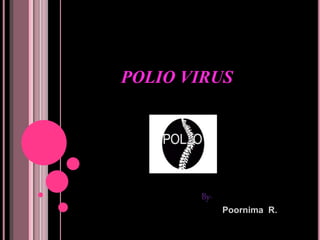
Poliovirus
- 2. WHAT IS POLIOVIRUS??? Poliovirus, the causative agent of poliomyelitis, is a human enterovirus and member of the family of Picornaviridae. Poliovirus is composed of an RNA genome and a protein capsid. Enteroviruses are a genus of positive-sense single-stranded RNA viruses associated with several human and mammalian diseases. A picornavirus is a virus belonging to the family Picornaviridae. Picornaviruses are small, non-enveloped, positive-stranded RNA viruses with an icosahedral capsid.The viral particle is about 30nm in diameter.
- 4. Positive-strand RNA virus: Also known as a sense-strand RNA virus, a virus whose genetic information consists of a single strand of RNA that is the positive (or sense) strand which encodes mRNA (messenger RNA) and protein. Replication in positive-strand RNA viruses is via a negative-strand intermediate. A capsid is the protein shell of a virus. It consists of several oligomeric structural subunits made of protein called protomers. The observable 3- dimensional morphological subunits, which may or may not correspond to individual proteins, are called capsomers. The capsid encloses the genetic material of the virus.
- 5. Icosahedral structure These viruses appear spherical in shape, but a closer look actually reveals they are icosahedral. The icosahedron is made up of equilateral triangles fused together in a spherical shape. This is the most optimal way of forming a closed shell using identical protein sub-units. The genetic material is fully enclosed inside of the capsid. Viruses with icosahedral structures are released into the environment when the cell dies, breaks down and lyses, thus releasing the virions. Examples of viruses with an icosahedral structure are the poliovirus, rhinovirus, and adenovirus.
- 6. What are serotypes Serotype or serovar are distinct variations within a species of bacteria or viruses or among immune cells of different individuals. These microorganisms, viruses, or cells are classified together based on their cell surface antigens, allowing the epidemiologic classification of organisms to the sub-species level. There are tree serotypes of poliovirus with common antigen. They have identical properties and their genomic base sequences share 36-52% homology. Poliovirus show marked antigenic stability.
- 7. TRANSMISSION OF POLIOVIRUS Poliomyelitis caused by poliovirus usually occurs in summer. When a person is infected with poliovirus, the virus resides in the intestinal tract and mucus in the nose and throat. Poliovirus transmission most often occurs through contact with stool of this infected person (known as fecal- oral transmission). Less frequently, polio transmission can occur through contact with infected respiratory secretions or saliva (oral-oral transmission).
- 8. SYMPTOMS Signs and symptoms, which generally last one to 10 days, include: Fever Sore throat Headache Vomiting Fatigue Back pain or stiffness Neck pain or stiffness Pain or stiffness in the arms or legs Muscle weakness or tenderness Meningitis
- 10. PATHOGENESIS Poliovirus replicates in cells of human gastrointestinal tract and is excreted in feces. In rare cases it invades Central Nervous System(CNS) and causes paralytic disease called poliomyelitis. Incubation period is 7 to 14 days. Following ingestion, The virus multiplies in oropharyngeal and intestinal mucosa. The lymphatic system, in particular, the tonsils and payer’s patch of the ileum is invaded. The virus enters the blood resulting in viremia.
- 11. TREATMENT AND PREVENTION Active immunization can cure Polio. There are two vaccines available; Inactivated Salk Vaccine and Attenuated Sabin Vaccine. The former, also called formalin inactivated Intramuscular Polio Vaccine (IPV),was developed by Jonas Salk. It contains an injected dose of three antigenic strains of killed polio virus. The later, also called Oral Polio Vaccine(OPV),was developed by Albert Sabin. It contains attenuated forms of poliovirus.
- 13. REFERENCE Somnath Dutta,2010,Textbook of Virology, Adhyayan Publishers and Distributors, New Delhi. Fritz H. Kayser, Kurt A. Bienz, Johannes Eckert, Rolf M. zinkernagel,2005,Medical Microbiology, Thiem, New York. www.google.com www.wekipedia.org